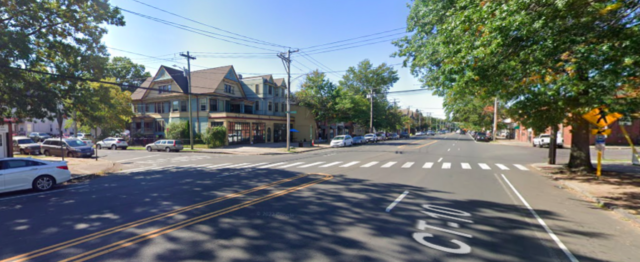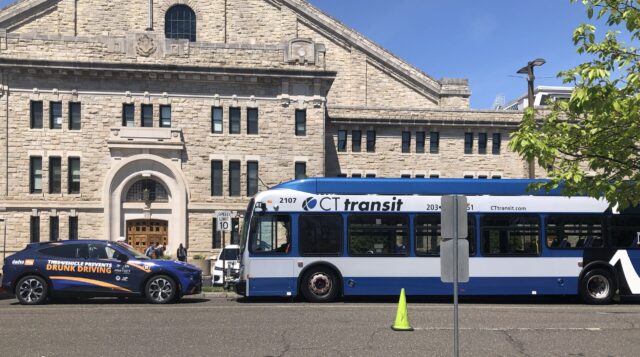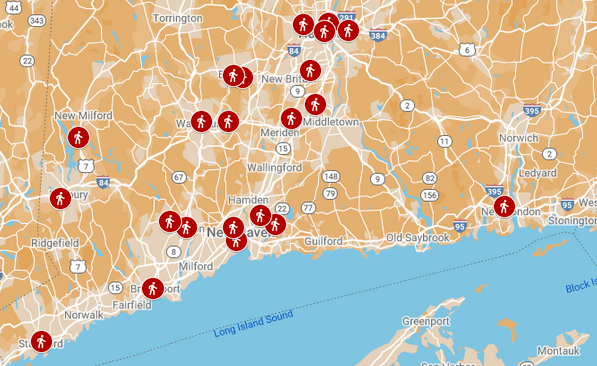New Haven
Both of the pedestrians killed in New Haven, so far, this year have died on Route 10. When I talk about these being preventable deaths, and typically predictable deaths because of negligent road design, this is exactly to what I am referring.
Scholar and peace activist Yusuf Gürsey, 70, became the 14th pedestrian/cyclist to die on New Haven’s stretch of Route 10 since 2015. Yusuf had called New Haven home for 40 years. Just before 9:30 PM on April 28, 2024, the New Haven resident was struck at the intersection of Brownell Street and Route 10, which also goes by the name Whalley Avenue in this location. Multiple pedestrians have also been killed on the non-Route 10 portion of Whalley Avenue since 2015.

Despite this being a densely populated area with businesses lining the street, decision-makers have taken little effort to ensure that pedestrians could cross it safely. There are bus stops at this intersection and a painted crosswalk on only one leg of the intersection, but no pedestrian signal or even a stoplight that might help someone cross four lanes of traffic, plus two parking lanes. The speed limit is posted as 25 MPH, but there’s nothing to incentivize a motorist to actually travel at a low speed at night when roads are less congested.
Last fall, the State Bond Commission okayed a measly $1M to make Whalley Avenue more walkable and bikeable; that construction project is supposed to have begun this year with a wrap up date of 2026. According to the New Haven Register, these improvements will include “new sidewalks, better lighting and a mid-block raised crosswalk to make it safer for people to get to the nearby Super Stop & Shop plaza,” which isn’t nothing, but it’s next to that. For those who don’t know, it’s expensive as hell to fix intersection lights, and the price varies by complexity of intersection. To add another layer of safety at even one intersection, there would be a price tag of anywhere from half a million to $1M — just for lights at one intersection. Notice that this is not in the Whalley Avenue walkability project. It couldn’t be. They’ve barely budgeted for it.
Construction should begin in 2026 on bus rapid transit on Whalley Avenue. It’s unknown to me if any additional pedestrian improvements will be made at that time or if this will be no more radical than simply painting lanes another color. New Haven has shown itself to have the ability to make changes elsewhere in the city, but when it comes to Route 10, there’s no drive.
These efforts need to be more and should have happened decades ago.
A question that advocates wrestle with is this: how do we get decision-makers to do their jobs up to our standards? Here’s an idea that’s crazy enough to work:
View this post on Instagram
In the meantime, folks who live in New Haven or use Route 10 often should feel empowered to demand that decision-makers take safety more seriously and act with more urgency. There is no reason quick build solutions can’t be installed in a matter of days.
Because Route 10 is a State of Connecticut managed roadway, contact the CT DOT and demand that they push for more improvements on Whalley Avenue, including ones that would truly calm traffic down enough so that 70-year old civic leaders aren’t being killed on their walk home at night. Call them: 203-238-6240.
Additionally, contact Mayor Elicker: MayorElicker@newhavenct.go and contact New Haven’s Director of Transportation, Traffic & Parking: SAysola@newhavenct.gov, and if you’re feeling extra sassy, you might ask them how much money has been wasted on ensuring a heavy police presence at nonviolent protests when that money could have been better spent on curb extensions or bollards or speed humps. How many flex posts could New Haven have purchased for what was spent on stationing police at Union Station on Sunday, April 28, 2024?
New London
On April 10, 2024, a 25-year old driver killed Geneva DeLabry, 88 of Groton Long Point, as she walked through a New London strip mall parking lot.
This happened around noon on a clear, dry day.
The media did not explain why the motorist failed to yield to the elderly pedestrian.
Since 2015, there have been at least six other crashes in this lot that resulted in a pedestrian being injured; some of these strikes occurred while pedestrians were using marked crosswalks or crossing in front of a speed hump, asking the question of why drivers are going so fast in a parking lot and why there has not been a dramatic redesign of it. Because this is private property, local residents and frequent lot users should contact the property owner(s) and request that safety improvements be made; nobody should be getting killed in a parking lot.
Hartford, East Hartford, North Haven
Last month, three pedestrians were killed on Connecticut’s highways — and none of the media coverage provided explanation for why any of the pedestrians were using them, so we don’t know if they were standing outside of disabled vehicles, trying to cross, or using the interstate for another reason.
Around 9:15 PM on April 1, the driver of a Ford Explorer hit and killed Arthur Taylor, 71 of New Haven on I-91 in North Haven. According to the CT Crash Data Repository, the driver first hit work zone/maintenance equipment. Arthur was an activist, and the first of two New Haven activists to die as pedestrians last month.
Around 8:15 PM on April 13, the driver of a Honda Pilot EX-L SUV struck and killed Raphael Rodriguez, 32 of Torrington, as he was using I-84 in Hartford.
News reports were inconsistent about where on I-84 he was struck; the location assigned on the map matches what was later provided in the CT Crash Data Repository, and that does not match any of the media accounts. I’m sharing that as a reminder to be cautious about media consumption. Raphael is the second pedestrian killed on an Interstate in Hartford this year.
Around 8:40 PM on April 16, the driver of a Toyota Prius killed Randy Casado, 28 of Brooklyn, NY. Randy was reportedly in the HOV lane on I-84 in East Hartford when he was hit.

Yesterday, I saw the following in front of the Armory, near the Legislative Office Building. I don’t know exactly what they were doing, but I had to laugh because the lettering on the SUV should have also been on the bus parked to the right of it: “THIS VEHICLE PREVENTS DRUNK DRIVING.”
Ignition interlock devices as a standard on all vehicles — like seatbelts and airbags — feels like a no-brainer, as does working constantly and authentically to change our culture so that people understand public transportation to be an inexpensive and safe alternative to driving while impaired, and the State of Connecticut needs to make public transit run later in the evening, along with more frequently than it does. That’s just to start.
